The Fallacy of Janus at The Supreme Court
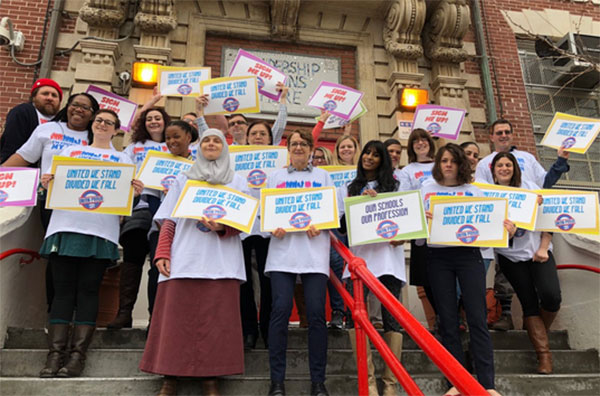
photo: @UFT
The Supreme Court of the United States will shortly rule on the Janus v. AFSCME case. Janus contends that any and all union activity is inherently political, that no one should have to contribute anything to union activity, and that we should therefore become a “right to work” nation. That’s an interesting concept.
My union, the United Federation of Teachers, has a political fund called COPE, and I contribute. I frequently disagree with UFT candidate endorsements and decisions, but I believe it’s important to empower our union. Not all of my friends believe that, but contributions to the political fund are strictly voluntary.
Union does, however, help press for things like higher pay, better working conditions, and increased benefits. We teachers and our union are frequently criticized for those demands. I see our working conditions as student learning conditions. I see our profession as a pathway to the middle class. At least two of my former students are now my colleagues, something I’m proud of. I think it’s our responsibility to leave our profession better for future generations. Of course, others may disagree with what we strive for.
It’s entirely possible there may be a class of teachers who want more work, less pay, and fewer benefits. A ruling for Janus, which would certainly weaken unions, could help achieve that. I’m UFT chapter leader at the largest school in Queens, and I represent Democrats, Republicans, and independents. I’ve never met a single member who wanted more work, less pay, and fewer benefits, but I don’t doubt they may exist. There are over 200,000 UFT members, and I don’t know them all.
Nonetheless, I’m fascinated by the concept that Americans ought not to be compelled to contribute toward political activity that, at least in theory, benefits them. If SCOTUS rules for Janus (and smart money says it will), then this “freedom” ought not to be limited to union activity. For example, like many Americans, I don’t want to pay for Donald Trump’s golf outings. Why, then, is my money covering those trips?
In fact, I don’t really want to pay for Jared and Ivanka in the White House either. I understand Ivanka may not be taking a salary, but I’m sure she incurs expenses -- an office in the White House can’t be cost-free. Why do I need to pay for the space and upkeep? I’d like to opt out of that as well.
It’s entirely conceivable that Donald Trump may start a war to divert attention from the ever-rising tide of scandal that perpetually engulfs him. If he does, I’d rather not pay. If he ever builds that wall, I don’t want to pay for that either. I could go on.
I understand that, under the new Trump tax system, New York will be further picking up the tab for states that levy little or no income tax. Why should New Yorkers have to do that? If other states don’t wish to tax their citizens, it shouldn’t be up to us to build their roads or pay for their services. Maybe, like the union members who want more work for less pay, those states have residents who don’t want roads or services. They should have the absolute right to live without them, and we ought not to get in their way.
Like a state or country, a union is a group of people who share an interest. Together we try to make things better for our group. We work together to advance our interests, and that’s why we have collective bargaining. I understand that, in a large union and in a democracy, I may not always agree with the direction in which we’re moving, but I have to do my part. And more broadly, I understand, as a citizen, that I have to do my part.
I freely acknowledge that our union may not be adequately representing the interests of teachers who want more work for less pay. I can understand that they may wish to opt out of union dues, even if doing so leaves them with more pay in the short run. (Call me cynical, but, if the SCOTUS ruling goes for Janus, I suspect some people who don’t want more work for less pay will also opt out just to save a few bucks.) The fact is that so-called right to work states have lower pay and fewer benefits, and that could become the norm after Janus.
However, if union activity is inherently political, so is government activity. If people are permitted to opt out of union dues, we ought to also be able to opt out of taxes. As soon as we can do that, I will consider supporting Janus.
But until that happens, everyone who benefits from a union should pay their fair share.
***
Arthur Goldstein is an ESL teacher and UFT chapter leader for Francis Lewis High School. On Twitter @TeacherArthurG.
***
Have an op-ed idea or submission for Gotham Gazette? Email This email address is being protected from spambots. You need JavaScript enabled to view it.
The Failure of 'Renewal Schools'
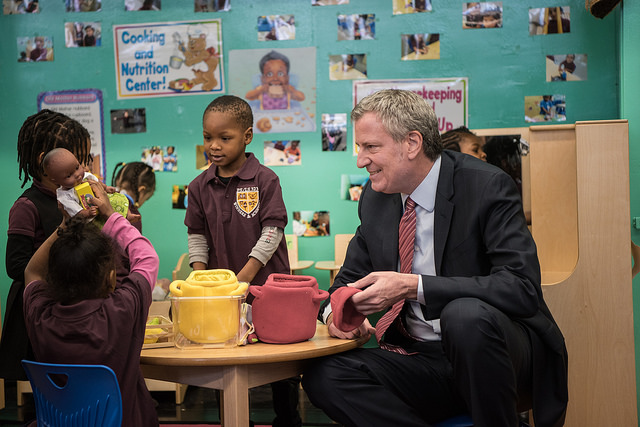
Mayor de Blasio on a school visit (photo: Michael Appleton/Mayor's Office)
My daughter is a third-grader in one of Mayor de Blasio’s so-called Renewal Schools in Harlem. When I first heard about the program, I was hopeful: P.S. 149 needed attention and change to become the kind of school I wanted for my daughter. But, as a parent, I have not seen much renewal.
Since the program started, enrollment at P.S. 149 has dropped 25 percent. For the kids who have stayed, scores haven’t improved much – students passing the English Language Arts exam has gone from 5 percent in 2014 to 13 percent in 2017. The math pass rate has dropped from 8 percent to 5 percent over the same time. So despite all the resources the Department of Education claims to have pumped into our school, fewer students are doing math at grade level.
When Mayor de Blasio announced his Renewal Schools program, he promised that his “bold new plan” would be the key to turning around chronically-struggling public schools like my daughter’s. Four years and $600 million later, there is little to show for it. None of the schools have come close to any sort of “renewal” and the mayor has been forced to close nine of them and merge others. Just a handful of the original 94 Renewal Schools have seen real improvement.
For me, this broken promise means a lot more than just numbers on a state test. My daughter is struggling in reading and math, and nothing the mayor has done these past few years has helped her school improve.
When I realized my daughter needed extra help, I reached out to the school’s parent coordinator – I’m not about to give up on my child. The coordinator promised to look for outside resources that might offer her the support she needs. I appreciate the effort, but why do we need outside resources when our school is supposed to be part of the mayor’s major project? If his program were of high quality, my daughter’s school would be able to provide a good education for kids inside the classroom, and parents like me wouldn’t be scrambling.
I am so discouraged with the state of the district schools in my neighborhood. The system is failing communities like mine all over the city – the same communities that elected this mayor. At the end of the day, it’s becoming clear that we can’t depend on Mayor de Blasio to improve struggling schools for children of color.
That’s why I’m trying to get my daughter a spot in a charter school, where kids like her have a shot to catch up. It’s really her only hope.
The problem is that there aren’t enough spaces at charter schools. I guess the mayor knows that if parents like me had a choice, we’d leave, just like a quarter of our school already has.
The mayor shouldn’t be the only one with a say here. The New York City Council will be holding a hearing on Tuesday, Feb. 27 – and I hope Council members get to the bottom of this failed experiment. Our Council members live in our neighborhoods and they see what’s happening in our schools. They need to step up because our communities can’t wait another four years for Mayor de Blasio to figure things out.
As I keep fighting for my daughter, my son is getting ready for kindergarten. I am trying to do everything I can to make sure he’s on a better path. Knowing what I know now, I am fighting like hell to get him into a charter school right from the start. As a single mom, juggling two different schools will be hard, but I would do anything to get my kids a better education.
If Mayor de Blasio was really focused on turning around struggling schools, me and my kids wouldn’t be in the situation we’re in now. The mayor’s “bold new plan” is nothing more than another broken promise.
***
Aradany Vargas is a public school parent at P.S. 149 Sojourner Truth.
***
Have an op-ed idea or submission for Gotham Gazette? Email This email address is being protected from spambots. You need JavaScript enabled to view it.
Let’s Lead the Way on Gun Background Checks in New York
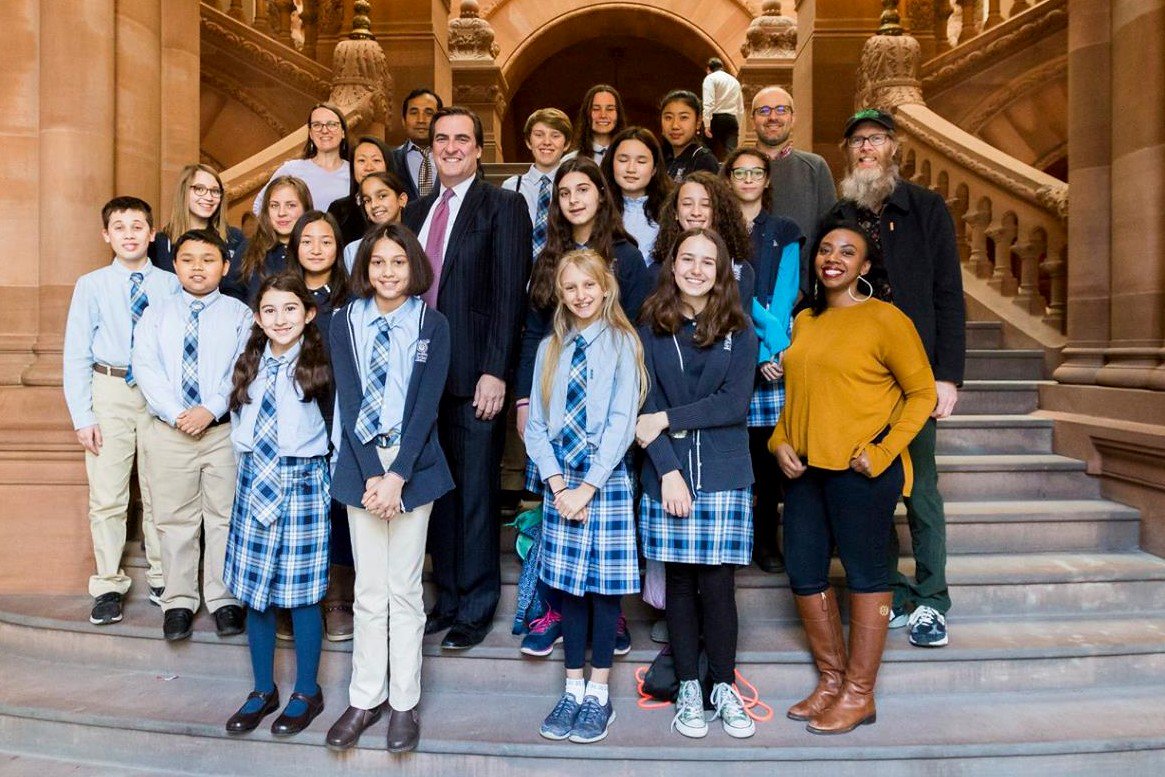
Senator Gianaris, the author, with young people (photo via @SenGianaris)
72 hours.
That is how long one needs to wait for a background check before buying a high-capacity gun capable of mass slaughter. Three days is all it took for Dylann Roof to purchase his .45 caliber Glock and kill nine people who sat praying in Emanuel AME Zion Church in Charleston, South Carolina. Roof bought his gun without completing a background check because current law authorizes a gun purchase after three days, regardless of whether or not a background check has been completed. Roof, with his prior convictions, would have failed a background check and should not have been able to acquire his firearm. The victims should still be with their families today.
Right here in New York, Jiverly Wong purchased a handgun in Binghamton in 2009 after three days, even though a background check – which may have prevented the purchase due to a history of mental health issues – was not completed. Just a month later, he walked into a naturalization class at a local community center and killed 13 people.
As the nation reels from another horrifying tragedy, this time in Parkland, Florida, thoughts and prayers are insufficient to stop future calamities. The time for action is at hand. Grieving teenagers mourning their classmates should not shoulder the burden of a nation; state and federal leaders must do something to prevent even more parents from burying their children.
In 2016, the federal government authorized more than 300,000 prospective gun purchases before background checks were completed. This means thousands of weapons in the hands of potentially dangerous people – those with criminal histories and mental illnesses, as well as domestic abusers.
In New York State, we can lead the way on avoiding these preventable tragedies: I introduced the Effective Background Check Act, legislation lengthening the waiting period for a background check from the current three days to a full 10, giving more time for checks to be completed and keeping weapons out of the hands of potential killers.
This effort is even more important now as the Trump administration seeks to reduce funding for the National Instant Criminal Background Check System (NICS), which would further slow the ability of the FBI to perform timely background checks. As Parkland parents buy caskets for their children instead of graduation gowns, Donald Trump needs to recognize this is the worst possible time to abdicate his responsibilities.
Leaders on all sides of the aisle must rally around the crisis our nation is facing: too many people are dying of preventable gun deaths. On average, 96 people die each day from guns. Because of background checks, we have stopped more than 3 million gun sales to prohibited people, saving countless lives. With a longer waiting period, we could save even more.
Could a few days’ time have made a difference in these tragedies? Could one of those more than 300,000 gun purchases in 2016 be the next mass shooting? Could one of those be the perpetrator of domestic violence against his or her partner or child? Are those extra hours worth saving the lives of innocent men, women, and children who may be gunned down in movie theaters, on street corners, or in their schools?
240 hours. That is how long a gun purchaser would need to wait to complete a background check if New York enacts my Effective Background Check Act. For all those whose lives were cut short by years, we owe them this extra time.
***
Michael Gianaris is a state senator representing the 12th Senate District, in Queens. On Twitter @SenGianaris.
***
Have an op-ed idea or submission for Gotham Gazette? Email This email address is being protected from spambots. You need JavaScript enabled to view it.
Teaching Black History in Our Schools
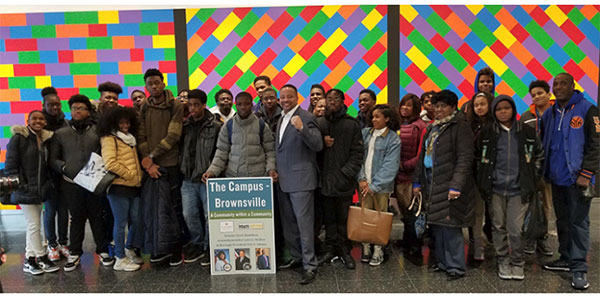
Senator Jesse Hamilton, the author (middle)
Last summer, I hosted a hackathon for middle school students at Medgar Evers College. Picture 40 enthusiastic young people ready to learn about coding, computer science, and technology, along with CodeEd educators and the welcoming college staff.
In an effort to be as educational as possible, I like to do a little history quiz when we host young people. My quiz features questions like, “Who was the first African-American woman elected to Congress?” That day, I asked, “Who was Medgar Evers?” Silence. The question stumped nearly all the students.
Only one student could venture a reply on his Civil Rights Movement leadership. That lone reply is part of the reason I am advancing legislation to make black history instruction in our K-12 schools mandatory.
The Southern Poverty Law Center recently published a troubling report on schools teaching the history of slavery, “Teaching Hard History.” Among the most alarming findings, SPLC reports that two-thirds of high school seniors did not know it took a constitutional amendment to end slavery; 58 percent of teachers found their textbooks inadequate in teaching about slavery; the average textbook scored only 46 percent in SPLC’s assessment of what should be included in the study of American slavery; 40 percent of teachers believed their state offers insufficient support for teaching about slavery.
The SPLC’s analysis provides important data supporting the need to make black history instruction mandatory, mirroring my experience with the hackathon students and elsewhere.
Recent news reports underscore the necessity of this legislation. In one Bronx school, I.S. 224, the principal reportedly instructed an English teacher not to teach about the Harlem Renaissance. In another school, administrators refused to allow a student named Malcolm Xavier Combs to put “Malcolm X” on his senior sweater. In another instance, in Park Slope, the PTA included images of performers in blackface on advertisements for a 1920s themed fundraiser. Passing this law would send a clearly needed message of inclusion to all New Yorkers.
Black history’s importance extends far beyond a single month. From the abolitionists like Sojourner Truth, who broke barriers in advocacy and helped end slavery, to the Harlem Renaissance, home to literary and artistic dynamism we benefit from even today, to the pioneering achievements of Shirley Chisholm, who paved a path for future public servants of color, men and women alike, black history serves as part of our national heritage.
Our young people should engage with black history in thoughtful, age-appropriate ways, throughout their time as students. Black history provides a panoply of avenues across subject areas for K-12 students to explore, intersecting with social studies, English language arts, performing and visual arts, and more. I have every confidence that the Board of Regents and educators across various disciplines can successfully weave the richness of black history and New York’s unique place in black history into school curricula.
A crossroads for the world, New York’s Black History intersects with experiences of the Afro-Caribbean community, the Afro-Latino community, and the entire African diaspora. Under the provisions of my black history in schools proposal, the Board of Regents would be responsible for determining how Black History is best incorporated into students’ studies.
Sociologists point to the black experience being underrepresented overall in media, missing stories altogether, exaggeration of negative portrayals, and providing positive portrayals within only a narrow scope. These broader facts have consequences for young peoples’ development, self-esteem, expectations, and what figures are even available as role models. Requiring black history in schools is not a silver bullet, but it marks an important further development in chipping away at stultifying boundaries to opportunities.
I invite the public to join in support of an holistic effort to think about black history and participate in embracing a curriculum recognizing New York’s unique place in black history. New York is blessed with a rich variety of institutions that can contribute to making this inclusive move a success, the Weeksville Heritage Center in Brooklyn, the Schomburg Center for Research in Black Culture in Harlem, and all our museums, libraries, and numerous institutions of higher education can make valuable contributions to this effort.
This broader integration of black history into our schools is as important to our future as the coding and computer science those middle school students learned at Medgar Evers College. Such a curriculum leaves the boundaries of the schoolhouse and will help bolster New York students’ college- and career-readiness, engaging them, sharpening their skills, and preparing them for the diverse and dynamic communities they will lead their lives in.
***
Jesse Hamilton is a state senator representing Brooklyn’s 20th district. On Twitter @SenatorHamilton.
***
Have an op-ed idea or submission for Gotham Gazette? Email This email address is being protected from spambots. You need JavaScript enabled to view it.
The Diversity Visa: A Ticket To A Better Life
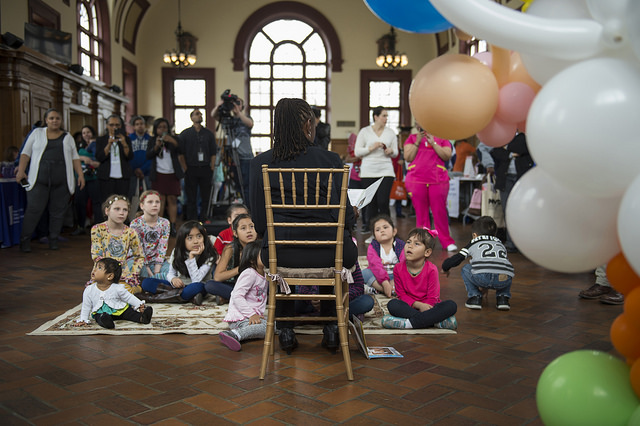
(photo: Ed Reed/Mayor's Office)
This past October my mom passed the United States citizenship exam. On November 7, she became a U.S. citizen. And this past December my dad passed the United States citizenship exam. On January 31, he became a U.S. citizen. Soon, my sisters and I will become U.S. citizens as well. None of this was guaranteed to us, and it almost didn’t happen.
My family is from Bangladesh. We moved to the United States in July 2011 through the Diversity Visa process, which is currently being called into question at the federal level, especially after a recent terrorist attack in New York City. The experience of my family -- me, my parents, and my two younger sisters -- is a testament to what the Diversity Visa program can do for people, and for the United States, a country we are proud to call home.
Simply put, the Diversity Visa changed our lives. It gave us a second chance. It allowed me to be where I am today: 15 years old and a tenth-grader in a New York City high school.
In Bangladesh, my dad was a businessman, running a company called Nicos Digital Color Lab. Armed with a bachelor’s degree, he was also a self-taught photographer, and sometimes taught computer lessons to high school students. My mom has a master’s degree, and helped to support our home.
Back in Bangladesh, there was a lot of pressure on my parents: my grandparents, two cousins, two uncles, and an aunt all lived with us in the same house. My dad paid all of our family’s expenses, and my mom cooked and took care of everyone. The entire family depended on my parents, and it put an obvious strain on their marriage. Things began to fall apart between my mom and my dad. Since they were the caretakers, though, no one much noticed.
One day, when my dad was in his Color Lab staring at his computer screen, one of his friends stopped by and asked for a cigarette. He told my dad to apply for the Diversity Visa to the U.S.
My dad laughed at first, “A common person like me, with no extraordinary talents, living in a small town in a country named Bangladesh, will get a visa to go to the United States?”
My dad’s friend smiled and told him to ask my mom to apply. “Your wife is your lucky charm. Her application will get accepted.” My parents quickly filled out an application under my mom’s name.
Soon after, we received a first letter notifying us that we had been selected, and then a second letter notifying us that we would be interviewed. After an extensive vetting process, we were approved. My mom, my sisters, and I were given a visa. A month later, my dad’s visa was approved as well. While the process may seem easy, it was not. It took time, preparation for the interviews, and anxiety until the visas were in hand.
As we looked up airline tickets to go to the U.S., we realized we didn’t have enough money to get there. But, we soon found, miraculously, that our family was surrounded by supportive guardian angels. All my dad’s childhood best friends came to our rescue. They all contributed, not only helping to pay for our plane tickets, but providing extra money to survive in the U.S. as we started our new lives.
After moving to the U.S. and gaining employment, my dad paid all their money back. But we will never be able to give back the generosity, kindness, and opportunity they gave us. I am forever grateful to my dad’s friends for helping to change our lives.
In the years since, we have established our lives in the U.S. It has not been easy. My father, a former businessman, works as a taxi driver. My mother, with her master’s degree, takes care of my sisters and me. We all go to school, studying for a better future for our family. But we feel so lucky to be living in the United States. It has changed our lives immeasurably.
If we were still in Bangladesh, I’m confident that my family would have fallen apart, and my parents might have separated. My sisters and I wouldn’t have been able to receive a proper education because education in Bangladesh costs so much. I wouldn’t be independent, navigating the subways of New York City on my own. I wouldn’t have my parents as close to me as they are to me right now, and they probably wouldn’t be able to give much time to my sisters and me as they do right now. My parents wouldn’t be able to financially support my grandparents and all their siblings as they do now.
Getting settled here in the United States was not easy; it still isn’t. Adjusting to the new environment around us, being away from our extended family, hearing threats because we are Muslims and people see us as foreigners. But life is better. And there is the possibility of an even better future. A future I work toward every day at school.
That is what the Diversity Visa has meant to me. A ticket to a better life.
The United States is my home. It always has been. I may not be born here, but I am an American. I love this country so much. The Diversity Visa changed my family’s life forever. For that for so many Americans to come, I pray we do not get rid of it.
***
Laila Dola is a high school student in Queens and a former member of the Generation Citizen Student Leadership Board.
***
Have an op-ed idea or submission for Gotham Gazette? Email This email address is being protected from spambots. You need JavaScript enabled to view it.
Education Adrift: New Chancellors Needed for City School, University Systems
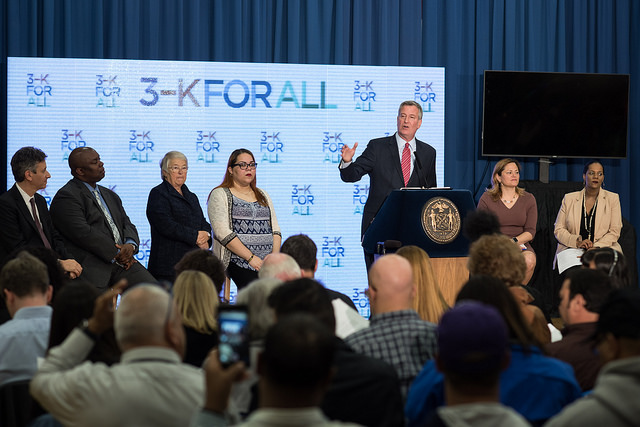
Mayor de Blasio, Chancellor Fariña & others (photo: Michael Appleton/Mayor's Office)
Lame duck chancellors now lead New York’s school and university systems. Governor Cuomo, who controls the CUNY board, and Mayor de Blasio, who appoints the schools chancellor, each show a shocking lack of urgency to fill these critical posts.
This is intolerable. Education is the driver of our information age. Social progress and economic prosperity depend on a vibrant public sector commitment. The city Department of Education enrolls a million children, pre-K through grade 12. CUNY enrolls 275,000 undergraduate and graduate students. Yet our elected leaders allow these essential institutions to remain rudderless.
Our schools and colleges should be brimming with excitement. New technologies, exploding fields of scientific endeavor, novel business opportunities, and a wealth of artistic media make this a particularly fertile time to teach and to learn. A new generation of education leaders is needed to meet this challenge, ready to bring vision and creativity to jobs that have become handmaidens to parochial political interests.
The leadership vacuum holds us back. New York’s position as the World’s Capital is threatened by educational backsliding and neglect. When Mayor de Blasio announced that Carmen Fariña’s successor would be cut from the same mold, my heart sank. Not that she’s been a bad chancellor but because we need a new chancellor, filled with original ideas and vision.
And who beside insiders even know the CUNY Chancellor’s name? James Milliken announced his departure three months ago after just three years on the job. His tenure has been marked by defending repeated charges of long-term fiscal mismanagement. Belated filling of vacancies on the CUNY board by Governor Cuomo and tensions surrounding appointment of City College’s new president added to system-wide stasis, a lost opportunity when Columbia, NYU, and Cornell’s new Roosevelt Island campus are all expanding.
Union leadership has been complicit in this lack of forward motion, settling into predictable cycles of management opposition and compliance for short-term interests. But Michael Mulgrew of the UFT and Barbara Bowen of PSC-CUNY, each safely ensconced in their positions, should do much more. New York labor leaders have historically been national figures, fighting tooth-and-nail for their members and the public good. Innovative contract terms can be an engines for implementing instructional progress if union sights are raised above routine salary demands.
Current belt-tightening by the federal, state, and city governments should not be an excuse for treading water. If anything, the budget picture requires increased institutional agility. Consolidation of organizational structures may be necessary, requiring different operational strategies. Principled reform of antiquated or unneeded functions can be catalyzed by cuts. Public officials’ well-known motto that “no serious crisis should go to waste” requires courage and consensus to implement. This is a challenge that requires new thinking, pointing again to the need for immediate change in the city’s top education posts.
This is a propitious moment for such change. With two ambitious politicians on the cusp of filling these leadership positions, a coordinated approach to New York City’s educational future is possible. Perhaps the Cuomo-de Blasio feud can find a moment of détente or realization that their mutual self-interest dictates summitry. With claims to being The Education Governor and The Education Mayor, the high-visibility appointment of quality chancellors for each of their fiefs will send a message of optimism and renewal that both can use to their advantage. Let us hope this flickering possibility can light our educational future.
- - -
David C. Bloomfield is Professor of Educational Leadership, Law & Policy at Brooklyn College and The CUNY Graduate Center. On Twitter @BloomfieldDavid.
***
Have an op-ed idea or submission for Gotham Gazette? Email This email address is being protected from spambots. You need JavaScript enabled to view it.
Three Voting Reforms New York Must Pass This Year
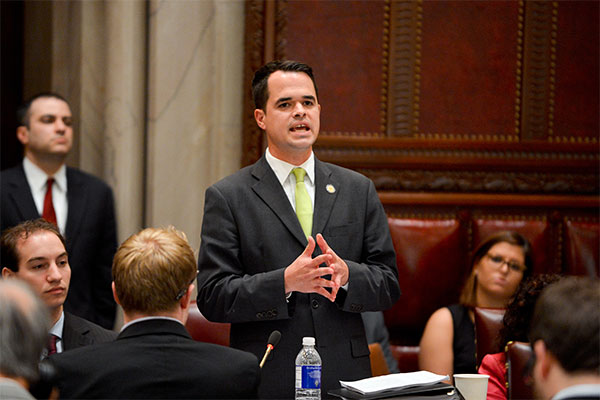
State Senator David Carlucci, the author
New York’s voting laws are woefully outdated and lag behind much of the rest of our country. Too many New Yorkers experience unfair and unnecessary restrictions when they wish to exercise their constitutional right to vote. Unsurprisingly, New York consistently ranks near the bottom in voter turnout when compared to other states.
According to 24/7 Wall St., an average of only 59.2% of eligible New York voters voted in the presidential elections from 2000 through 2012. That makes New York 42nd among the 50 states in voter turnout. As disappointing as these figures are, voter turnout has been even lower in midterm and state elections. This is why we need voting reform in our state.
I applaud Governor Cuomo’s 30-day budget amendment that calls for $7 million to fund early voting in counties across the state. New York is one of only 13 states that does not offer early voting, a deficiency we must change now. New Yorkers are busy, having the convenient option to go to the polls up to 12 days before Election Day means people don’t have to choose between going to work or school and voting. It is time we join the other 37 states and the District of Columbia (Washington, D.C.) and provide New Yorkers with access to early voting. A recent Siena College poll indicates that 65% of New Yorkers support early voting.
Automatic voter registration (AVR) is another proposal that New York should adopt. AVR allows people to be automatically registered to vote when they interact with the Department of Motor Vehicles. People would no longer have to worry about registration deadlines or application submissions. After witnessing the success of AVR in Oregon, eight other states have approved it. No citizen should ever be denied his or her constitutional right to vote, and we should make the registration process easy and convenient. I have fought for legislation to enact AVR since 2015. This is the year to pass it.
Finally, same-day voter registration (SDR) should be enacted so eligible New York voters can register to vote the same day they go to the polls. This eliminates registration deadlines people may miss. Fifteen states and Washington, D.C. have adopted some form of SDR. In their report entitled “America Goes to the Polls 2016,” Nonprofit VOTE and the U.S. Elections Project claim that same-day voter registration “has the most discernible impact on increasing voter turnout.” These organizations estimate that since 1996, states that allow SDR have experienced voter turnout seven to 13 points higher, on average, than states without SDR.
For too long, New York voting laws have suppressed voter turnout and have discouraged public participation in governance. I stand by the Governor’s plan to reform voting, and I encourage my fellow elected representatives to enact these proposals.
***
David Carlucci is the state senator representing the 38th Senate district. On Twitter @DavidCarlucci.
***
Have an op-ed idea or submission for Gotham Gazette? Email This email address is being protected from spambots. You need JavaScript enabled to view it.
The Transit Crisis Without A Rescue Plan
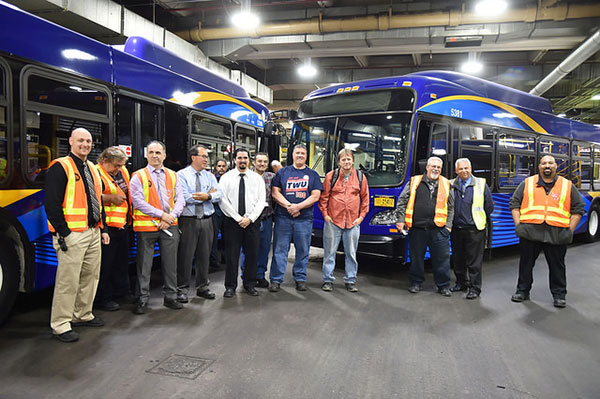
(photo: Kevin P. Coughlin/Governor's Office)
Even as the subways reach the breaking point, hundreds of thousands of New Yorkers face an additional commuting crisis: the lack of fast, reliable transit service in huge swaths of the boroughs outside Manhattan. In neighborhoods from Flatlands to Queens Village to Castle Hill, getting to work is a grinding chore, even when the trains are on time. That’s because the transit system has failed to keep pace with the demand for better service outside the city’s core.
Unlike the subway meltdown, this crisis still lacks a rescue plan. New York needs to get serious about improving bus and subway service outside Manhattan.
These punishing commutes are especially painful for the nearly half-million workers in the New York’s booming healthcare sector. The workers who heal us are hurting the most.
They face the longest mass transit commutes of any private-sector workers citywide—a median of more than 51 minutes—as revealed in a new report from the Center for an Urban Future, and their commutes have increased at more than double the rate of all workers in the city.
Roughly two-thirds of all healthcare jobs are in the boroughs outside Manhattan, with many far from the nearest subway. Of the city’s major healthcare facilities—including 21 hospitals and nearly 40 percent of nursing homes—our research found that almost one third are more than eight blocks from the closest subway station. This has given these nurses, health aides, and medical technicians a front seat to the shortcomings of an antiquated and broken system—assuming they can find a seat at all.
The slow and unreliable bus system compounds these frustrations, though there is rarely an alternative. More than 80,000 healthcare workers (17 percent of all employees in the sector) rely on buses every day—higher than any other industry.
Some sectors, like finance, have seen commutes shrink for city residents over the past two decades, as employees have moved closer to work. But healthcare workers have instead been pushed to the city’s more affordable periphery, especially the swelling ranks of home health aides, who typically make less than $25,000 per year.
Healthcare workers may have especially arduous commutes, yet the challenges they face reflect a broader trend reshaping New York City, where much recent job growth is occurring outside the Manhattan core. Thirty years ago, the four boroughs outside Manhattan were home to 35 percent of the city’s private sector jobs. Today, it’s 41 percent.
The boroughs have also been home to 87 percent of the city’s population growth since 1990, and most of the gains in transit ridership. But transit service has not kept pace with these demographic and economic trends. Meanwhile, little new investment has gone into improving existing service in these parts of the city—much less adding new service to address gaps.
To build a city that works for all of its residents, New York City and State needs to prioritize improving transit service in the Bronx, Brooklyn, Queens, and Staten Island.
New York’s local leaders need to get behind a congestion pricing plan, such as that proposed by the Fix NYC panel, that will create a dedicated revenue stream for transit improvements. Such a plan should absolutely fund much-needed subway fixes that help reduce delays and modernize signals. But part of these new funds must go into improving and expanding service in the boroughs outside Manhattan.
The MTA should also launch a Bus Rescue Plan to mirror the essential work happening in the subways, and New Yorkers should be heartened to hear that new New York City Transit chief Andy Byford mentioned the idea. He should waste no time in crafting one. For the two million New Yorkers who ride the bus each weekday, including more than 80,000 healthcare workers, buses are the only option. But bus service across the city is unreliable, too slow, and doesn’t run frequently enough.
The MTA and DOT should implement a host of best practices, including dedicated and enforced bus lanes, signal priority at traffic lights, and all-door boarding. These improvements would cost a fraction of what is needed underground.
With a new transit chief and subway action plan, New York City may finally be on the way to fixing the trains—a critical first step in turning around a failing system. Yet transit will forever remain on life support unless New York tackles the poor service plaguing neighborhoods citywide.
***
Bowles is executive director of the Center for an Urban Future. Chaban is CUF’s policy director. On Twitter @jbowlesnyc & @MC_NYC & @nycfuture
***
Have an op-ed idea or submission for Gotham Gazette? Email This email address is being protected from spambots. You need JavaScript enabled to view it.
Congestion Pricing Train Already Running Late in Albany

photo via the Governor's office
There is plenty of debate ongoing about the pros and cons of congestion pricing - but little discussion yet about the purpose of creating such a large flow of money -- $1-$1.5 billion a year -- that logically must be a way to fund the next MTA capital plan. That plan is due out in the fall of 2019 for a five-year cycle from 2020 through 2024.
The MTA had estimated that both the existing plan (2015-19) and the prior plan (2010-14) would cost about $30 billion each. For both plans, the MTA, the Governor, and the Legislature had trouble figuring out how to raise the money to cover such immense costs, and the 2010 plan was ultimately downsized. The next cycle will have the same problem: where to find money to pay for it. In fact, the problem of paying to keep the subway, bus, and commuter rail system in a state of good repair and pay for expansion projects will continue for decades.
In October 2013 the MTA put out its 20-year Capital Needs Assessment, 2015-2034, and identified needs which would cost $106 billion (in 2012 dollars) to pay to keep the system in a state of good repair, without even considering the cost of expansion projects. The cost of the expansion projects, East Side Access, Second Avenue Subway, and the LIRR Main Track, are $7 billion in the current plan. The State of Good Repair (replacing track, signals, stations, subway cars and buses, etc.) for the existing system is $25 billion in the current plan.
Governor Cuomo, MTA Chair Joe Lhota, and the Fix NYC panel have said very little about just how problematic the MTA’s long-term funding needs really are. There is a proposal in Gov. Cuomo’s new executive budget plan to force New York City to pay half the recurring maintenance costs of Lhota’s Subway Action Plan, estimated at $300 million a year by 2020, which Mayor de Blasio is refusing to support, but that is primarily for a step-up in regular maintenance, not capital projects.
The current capital plan had a shortfall of half the needed funds, $15 billion, until the Governor and the Legislature patched up the problem in 2016 by promising in state law the MTA would get the money when it needed it, meaning it would have to spend down what it had available first.
There is still no congestion pricing bill submitted by the Governor for the Legislature to consider, although in January the Governor’s Fix NYC panel issued its report that framed a congestion pricing scenario about the same time as he released his budget. A new state budget is due by the April 1 start of next fiscal year. That means the current discussions are more about whether the Legislature will even entertain the idea of charging vehicles to enter the Manhattan business district, without considering the specifics of the charges or what to do with the money.
The Legislature will skip convening in Albany during its annual mid-February break and not return until the end of the month at which point the Assembly and Senate will develop their one-house proposals for the budget. That begins a process in March to negotiate and adopt the next state budget by the April 1 deadline. The budget itself is controversial, as usual, with the Governor seeking $1 billion in new revenue to plug the deficit, and New York City complaining that his budget plan reduces or limits state aid to the city, or forces cost shifts, of $750 million, not counting proposed MTA cost-shifts.
For each house to prepare its budget proposal, scheduled for passage in mid-March, decisions will need to be completed by the end of the first week in March. With so many tough perennial issues to resolve for the budget, it is very possible that resolving major mass transit issues will be delayed until after the budget, with congestion pricing an open question.
State Comptroller Tom DiNapoli reported last fall the MTA was likely to face another $15 billion shortfall for the 2020-24 capital plan, and possibly much more because phase two of the MTA Subway Action Plan indicated a need for another $8 billion for New York City Transit. But right now the Governor, Chair Lhota, and legislators aren’t articulating this problem.
It is always important to note that it is an election year. If congestion pricing fails there will be a shortfall for the MTA of at least the sum of money congestion pricing would raise. If that was the case, there would be no place to go except another tax increase (and/or several large fare hikes) to fund the mass transit system. The City of New York can only raise the property tax. Only the state government can raise the payroll tax, the personal income tax, the corporate income tax, the sales tax, real estate transaction taxes, etc., or approve the City of New York raising any of its own taxes beyond the property tax.
Chair Lhota claimed the City is responsible for the capital needs of New York City Transit ($16-17 billion in the current 5-year plan) on the grounds that a 1953 law said so. That law, Section 1203 of the Public Authorities Law, did in fact say that but added that the City was responsible for $5 million a year, with anything more than that requiring mayoral approval.
That $5 million cap has not been changed since 1953; the law is an anachronism. When the MTA was created in 1968 the Legislature allowed the City to draw on bridge and toll surpluses for the mass transit system, and in 1981 began passing new state taxes within the MTA region, to dedicate to the MTA, for the obvious reason that the City can only raise the property tax. It is my considered opinion that the Legislature will not raise taxes (and the MTA will not do a fare hike) in an election year, so it’s congestion pricing or bust this year as far as mass transit is concerned.
***
Jim Brennan was a member of the New York State Assembly for 32 years, where he chaired four committees. On Twitter @JimBrennanNY.
***
Have an op-ed idea or submission for Gotham Gazette? Email This email address is being protected from spambots. You need JavaScript enabled to view it.
The real value of New York Islanders’ Belmont deal? Cuomo administration won’t say
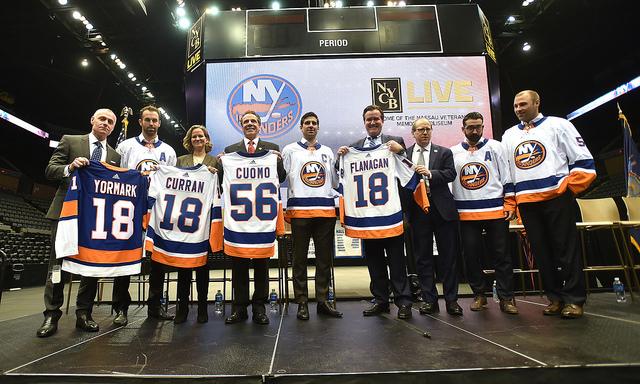
(photo: Kevin P. Coughlin/Governor’s Office)
A more transparent administration would reveal rival bid, economic estimates.
When Gov. Andrew Cuomo held a triumphant press conference on Dec. 20 to announce that the New York Islanders would return home to Long Island, building a new arena and ancillary retail, office, hotel space at Belmont Park, his economic development chief, Howard Zemsky, called the new project an "engine for economic growth."
Yes, as backers stress, underutilized parking lots would become sites for major activity, the Islanders would return home from an awkward stint in Brooklyn, and the $1 billion project would be "privately funded" (as Newsday bannered on its cover).
But unanswered economic questions loom.
Consider: the Islanders' expected 49-year lease (with renewal options), is valued at $40 million upfront. For a 43-acre site and $1 billion in investment, that price seems remarkably cheap. (For example, a half-acre commercial site in Garden City South is on sale for $2.5 million.)
To assess the bid by New York Arena Partners, the Islanders' consortium, we might compare it to that of the only rival, New York City Football Club (NYCFC), which sought to build a soccer stadium within a mixed-use development.
So I filed a Freedom of Information Law (FOIL) request with Empire State Development (ESD), the New York State economic development authority that oversaw the bids, to see them. My request was denied; the information “if disclosed would impair present or imminent contract awards,” I was told.
Wait a second. What's wrong with transparency? Why wouldn't it enhance legitimacy in this public process?
Even if the soccer team bid more, well, the ESD's Selection Committee scored base rent at just 20% of the overall evaluation. The hockey project could still be more deserving.
More importantly, what about the state’s overall estimate of economic benefits? My FOIL request met the same roadblock.
Such economic benefits -- along with the extent to which the proposed project “strengthens Belmont as a premier destination for entertainment, sports, recreation, retail and hospitality" -- made up only 30% of the overall score. The Isles' bid might again be a defensible choice, even if it scored lower on this metric.
But I doubt it scored lower. After all, over the regular season, the hockey team plays 41 home games, while the soccer team plays just 17.
Then again, what if the state's economic analysis ignored two elephants in the room, beyond the base rent and expected new jobs and taxes. "[T]he Long Island Railroad," Cuomo's press release stated vaguely, "is committed to developing a plan to expand LIRR service to Belmont Park Station for events year-round."
That commitment could be costly. Metropolitan Transportation Authority Chair Joe Lhota recently expressed concern, as Newsday noted, about the LIRR's capacity to add weeknight rush-hour trains.
He had no price tag for the service upgrade needed to accommodate westbound trains, something the Village Voice suggests would be extremely difficult. Shouldn't that overall cost, and the expected public share, have been part of the initial bid evaluation?
Moreover, Empire State Development has acknowledged that it conducted no market study to assess the Belmont arena's prospects. The new venue, especially if enhanced by LIRR service, likely would be successful -- but at the cost of luring events otherwise destined for the revamped, downsized Nassau Coliseum.
However, by announcing on Jan. 29 a part-time, short-term move by the Islanders to Nassau, Cuomo distracts from a decision his administration made that threatens the county-owned Coliseum. This twist comes with a $6 million state subsidy to upgrade Coliseum broadcast facilities and ice-making capacity, which also should be factored into the Belmont deal.
Cuomo seems to be rewarding not just Island hockey fans but also Brooklyn Sports & Entertainment (BS&E), which operates both Barclays and the Coliseum and seeks to shift Islanders' games from a money-losing environment in Brooklyn to an arena that could host more big events. (BS&E's not paying anything. Why shouldn't the arena operator and team shoulder the Coliseum costs, as Newsday suggested, or even ticket buyers and the NHL?)
These announcements may get Cuomo on TV. But successor elected officials likely will have to reckon with the ultimate public costs and untoward impacts of a new arena.
***
Brooklyn journalist Norman Oder writes the daily blog Atlantic Yards/Pacific Park Report and is working on a book about the project. On Twitter @AYReport.
***
Have an op-ed idea or submission for Gotham Gazette? Email This email address is being protected from spambots. You need JavaScript enabled to view it.




